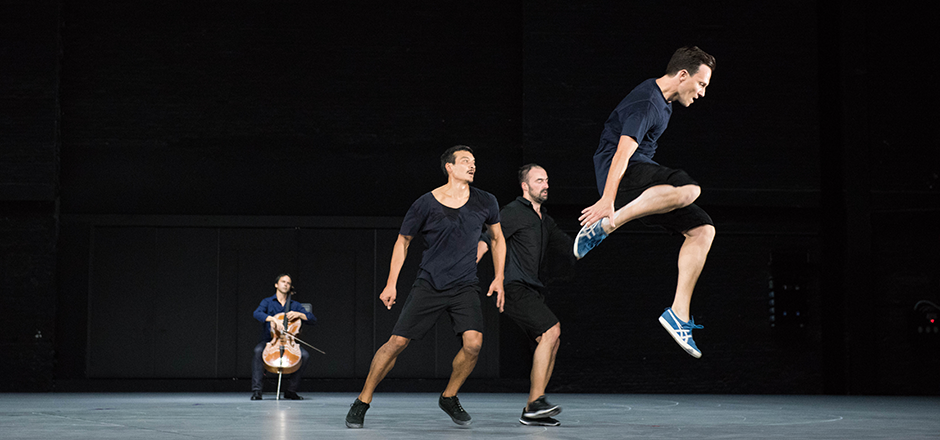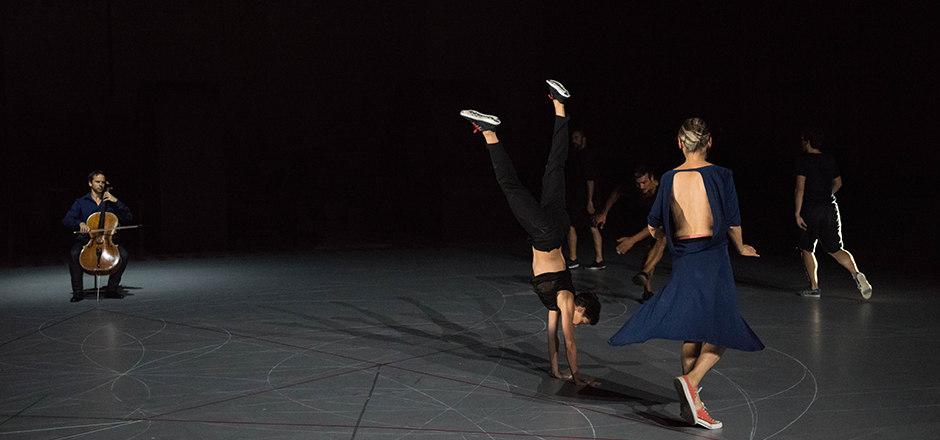LXXXI Festival of the Maggio Musicale Fiorentino
Dance
MITTEN WIR IM LEBEN SIND/BACH6CELLOSUITEN
Anne Teresa De Keersmaeker’s affinity with Bach was already apparent in several previous creations, and she continues to pursue a choreographic écriture that captures the essence of Bach’s musical language. In this production, Bach’s score, performed in its totality by the world-renowned cellist Jean-Guihen Queyras, is faceted, challenged, and performed through a choreography for three male and two female dancers, De Keersmaeker herself one of them. Both the individual character of the six suites and their mutual interconnections emerge from this riveting symbiosis of music and dance.
This first national performance of Mitten wir im Leben sind/Bach6cellosuiten is co-realized by Fondazione Fabbrica Europa, Fondazione Teatro del Maggio Musicale Fiorentino and Fondazione Teatro della Toscana.
In coproduction with Fabbrica Europa.
Mitten wir im Leben sind/Bach6Cellosuiten with the support of Tax Shelter del Governo Federale Belga.
In collaboration witha Casa Kafka Pictures Tax Shelter, empowered by Belfius.
Rosas is supported by Flemish Community.
World premiere: October 26, 2017, Ruhrtriennale, Bochum (Germany)
Artists
Choreography
Anne Teresa De Keersmaeker
Music
Johann Sebastian Bach - Six Cello Suites BWV 1007-1012
Sound
Alban Moraud
Dramaturgy
Jan Vandenhouwe
Light designer
Luc Schaltin
Costumes
An D’Huys
Production
Rosas
Coproduction
De Munt / La Monnaie(Brussel / Bruxelles), Ruhrtriennale, Concertgebouw Brugge, Philharmonie de Paris – Théâtre de la Ville – Paris – Festival d’Automne à Paris, Sadler’s Wells (London), Les Théâtres de la Ville de Luxembourg, Opéra de Lille, Ludwigsburger Schlossfestspiele, Elbphilharmonie (Hamburg), Montpellier Danse 2018
Italian’s corealization
Fondazione Fabbrica Europa, Fondazione Teatro del Maggio Musicale Fiorentino, Fondazione Teatro della Toscana
Anne Teresa De Keersmaeker
Music
Johann Sebastian Bach - Six Cello Suites BWV 1007-1012
Sound
Alban Moraud
Dramaturgy
Jan Vandenhouwe
Light designer
Luc Schaltin
Costumes
An D’Huys
Production
Rosas
Coproduction
De Munt / La Monnaie(Brussel / Bruxelles), Ruhrtriennale, Concertgebouw Brugge, Philharmonie de Paris – Théâtre de la Ville – Paris – Festival d’Automne à Paris, Sadler’s Wells (London), Les Théâtres de la Ville de Luxembourg, Opéra de Lille, Ludwigsburger Schlossfestspiele, Elbphilharmonie (Hamburg), Montpellier Danse 2018
Italian’s corealization
Fondazione Fabbrica Europa, Fondazione Teatro del Maggio Musicale Fiorentino, Fondazione Teatro della Toscana
Dancers
Boštjan Antončič, Anne Teresa De Keersmaeker, Marie Goudot, Julien Monty, Michaël Pomero
Cello
Jean-Guihen Queyras
Boštjan Antončič, Anne Teresa De Keersmaeker, Marie Goudot, Julien Monty, Michaël Pomero
Cello
Jean-Guihen Queyras
In 1980, after studying dance at Mudra School in Brussels and Tisch School of the Arts in New York, Anne Teresa De Keersmaeker (b. 1960) created Asch, her first choreographic work. Two years later came the premiere of Fase, Four Movements to the Music of Steve Reich. De Keersmaeker established the dance company Rosas in Brussels in 1983, while creating the work Rosas danst Rosas. Since these breakthrough pieces, her choreography has been grounded in a rigorous and prolific exploration of the relationship between dance and music. She has created with Rosas a wide-ranging body of work engaging the musical structures and scores of several periods, from early music to contemporary and popular idioms. Her choreographic practice also draws formal principles from geometry, numerical patterns, the natural world, and social structures to offer a unique perspective on the body’s articulation in space and time. From 1992 until 2007, Rosas was in residence in the Brussels opera house De Munt/La Monnaie. During this period, De Keersmaeker directed a number of operas and large ensemble pieces that have since been performed by repertoire companies worldwide. In Drumming (1998) and Rain (2001), both with Ictus contemporary music ensemble, complex geometric structures in point and counterpoint, together with the minimal motivic music of Steve Reich, created compelling group choreographies that remain iconic and definitive of Rosas as a dance company. Also during her time at La Monnaie, De Keersmaeker created Toccata (1993) to fugues and sonatas of Johann Sebastian Bach, whose music has continued to be a recurring thread in her work. Verklärte Nacht (both the 1995 version for fourteen dancers and the 2014 version for three) unfolded De Keersmaeker’s expressionist side, bringing the stormy narrative of Arnold Schönberg’s late romantic string sextet to life. She ventured into theater, text, and interdisciplinary performance with I said I (1999), In real time (2000), Kassandra - speaking in twelve voices (2004), and D’un soir un jour (2006). She highlighted the use of improvisation within choreography in tandem with jazz and Indian music in such pieces as Bitches Brew / Tacoma Narrows (2003, to the music of Miles Davis), and Raga for the Rainy Season / A Love Supreme (2005). In 1995 De Keersmaeker established the school P.A.R.T.S. (Performing Arts Research and Training Studios) in Brussels in association with De Munt/La Monnaie. De Keersmaeker’s latest pieces mark a visible “stripping down” of her choreography to essential principles: spatial constraints of geometric pattern; bodily parameters of movement generation, from the utmost simplicity of walking to the fullest complexity of dancing; and close adherence to a score (musical or otherwise) for the choreographic writing. In 2013, De Keersmaeker returned to the music of Bach (performed live) in Partita 2, a duet between herself and Boris Charmatz. Also in 2013, she created Vortex Temporum to the spectral music piece of the same name written in 1996 by Gérard Grisey. Taking her penchant for writing movements from musical scores to an extreme level of sophistication, Vortex Temporum had a one-to-one ratio between the Rosas dancers and the live Ictus musicians, bringing the choreography and the music into meticulous dialogue. In 2015 this piece was adapted to a durational exhibition format at WIELS in Brussels under the title Work/Travail/Arbeid. Also in 2015, Rosas premiered Golden Hours (As you like it), using for the first time a body of text (Shakespeare’s As You Like It) as the score for movement, thus allowing the music (Brian Eno’s 1975 album Another Green World) to recede from strict framework to soft environment. Later that year, Anne Teresa De Keersmaeker continued her research into the relationship between text and movement in Die Weise von Liebe und Tod des Cornets Christoph Rilke, a creation based on the eponymous text by Rainer Maria Rilke. At the beginning of 2017 she was invited by the Paris Opera to direct Mozart’s Così fan tutte. In A Choreographer’s Score, a three-volume monograph published by Rosas and Mercatorfonds, De Keersmaeker offers the performance theorist and musicologist Bojana Cvejić wide-ranging insights into the making of four early works as well as Drumming, Rain, En Atendant (2010), and Cesena(2011).
JEAN-GUIHEN QUEYRAS
"Queyras performs as he breathes…His technical ease allows him to play with the music, to knead it, giving a particular character to each work... The alternation of shadow and light, assumption and allusive asides is the essence of Queyras’ art...A packed house listened to him, gobsmacked, and in absolute silence. Queyras speaks of the world… he brings the universe to the end of his bow." Christophe Huss, Le devoir, Montréal, dec 2010 Jean-Guihen Queyras enjoys an enviable reputation as a musician of exceptional versatility and integrity. His musical horizons are seemingly boundless and he is in great demand both as a soloist with international orchestras and conductors, a chamber musician and as a solo performer. He has performed with many of the world’s great orchestras including The Philharmonia, Orchestre de Paris, NHK Symphony, Tokyo Symphony, Philadelphia, Tonhalle Zürich, Leipzig Gewandhaus, Budapest Festival Orchestra, Orchestre de la Suisse-Romande and Netherlands Philharmonique, under the baton of conductors such as Franz Brüggen, Günther Herbig, Ivan Fisher, Philippe Herreweghe, Jiří Bělohlávek, Olivier Knussen and Sir Roger Norrington. He is a regular soloist with several early music ensembles such as Freiburg Baroque and Akadamie für Alte Musik Berlin and he made his Carnegie Hall debut in New York with Concerto Köln in March 2004. His extensive repertoire incorporates a number of contemporary works and he has given several world premieres including Ivan Fedele’s cello concerto (Orchestre National de France, Leonard Slatkin) and Gilbert Amy’s concerto (Tokyo Symphony Orchestra at Suntory Hall, Tokyo). He has also premiered and recorded Bruno Mantovani’s concerto with the Saarbrücken Radio Sinfonieorchester and Phillippe Schoeller’s Wind’s Eyes with the SWR Sinfonieorchester Baden-Baden und Freiburg. He will be premiering a new cello concerto by Michael Jarrell in the 12/13 season, a co-commission by the orchestras in Utah, Lyon, Luxembourg and Suisse Romande. Jean-Guihen is frequently asked to host artistic residencies. These have included projects in the Muziekcentrum Vredenburg in Utrecht, the Concertgebouw in Amsterdam and De Bijloke in Gent. Since the 2010/11 season, he has been “Artist in Residence” with the Hamburg-based chamber orchestra, Ensemble Resonanz, with whom he leads and plays several eclectic programmes in the Laieszhalle Hamburg, Köln Philharmonie, Théâtre des Bouffes du Nord Paris, the Konzerthaus Wien and the Muziekgebouw Amsterdam. This residency has recently been extended to include the 2012/13 season. Furthermore, he will be soloist in residence of the Netherlands Philharmonic for the seasons 2011-12 and 2012-13. Jean-Guihen’s particular focus on repertoire for solo cello, which articulately demonstrates the exceptional narrative and expressive force of the monodic instrument, led him to devise and perform several series of concerts featuring the Suites by J.S Bach alongside contemporary works and he commissioned six composers (Kurtag, Harvey, Mochizuki, Amy, Nodaïra & Fedele) to write an ‘echo’ to each of the six Bach Suites for solo cello, in a project called ‘Six Suites, Six Echos’. He made his BBC Proms debut to unanimous acclaim (Haydn in C) in 2008 and appears regularly at the Aldeburgh Festival. His regular chamber music partners include the pianists Alexander Melnikov and Alexandre Tharaud and the violinist Isabelle Faust. He is a member of the Arcanto Quartet with Tabea Zimmermann, Antje Weithaas and Daniel Sepec, and performs regularly with Zarb specialists Kevan and Bijan Chemirani.


